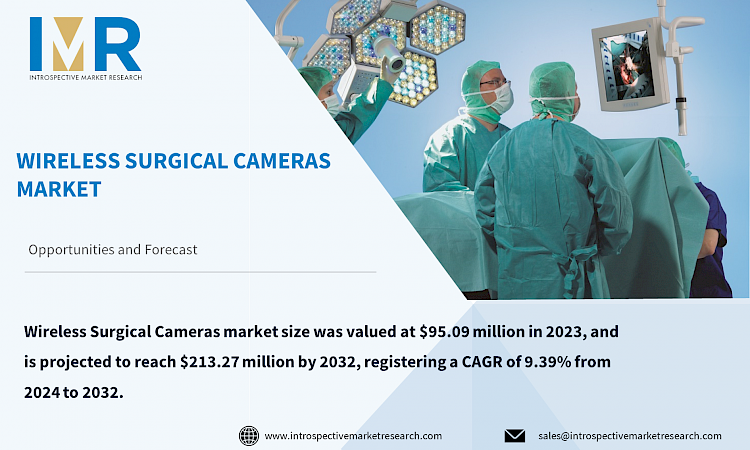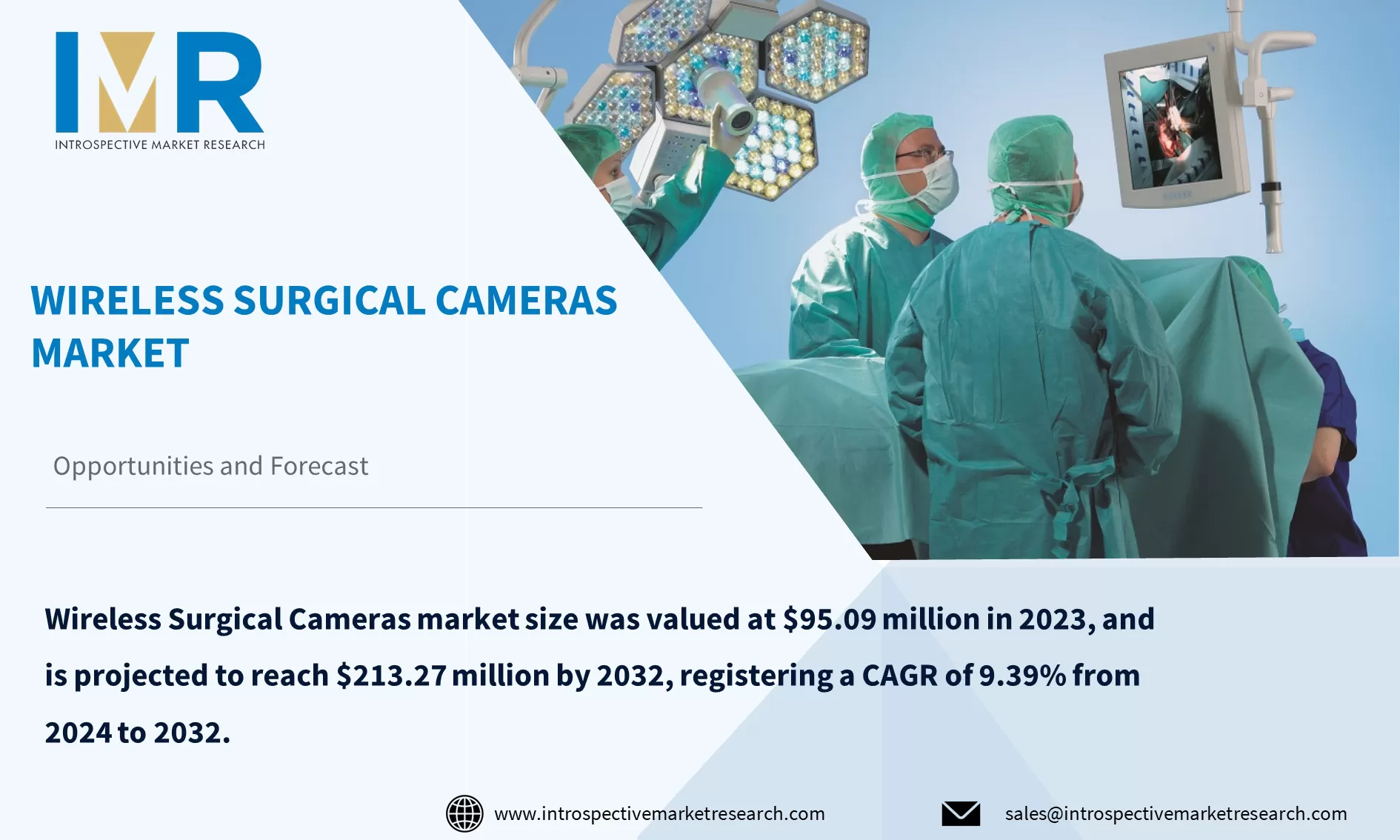
According to a new report published by Introspective Market Research, titled, ?Wireless Surgical Cameras Market by Product and End-User: Global Opportunity Analysis and Industry Forecast, 2024?2032
Global Wireless Surgical Cameras market size was valued at $95.09 million in 2023, and is projected to reach $213.27 million by 2032, registering a CAGR of 9.39% from 2024 to 2032.
Wireless surgical camerasare advanced medical imaging equipment that provide high-definition images and videos during surgical procedures, enabling surgeons to navigate complex anatomical systems. These devices eliminate large cables, enhancing mobility and versatility. They improve imagining, leading to better patient outcomes and lower risks. The wireless surgical camera market has grown rapidly due to advancements in medicine, less invasive procedures, and improved vision. They are used in various medical specialties, including orthopedics, neurology, gastrointestinal, and gynecology, and replace the standard two-cable camera system in minimally invasive procedures. Advancements in technology, such as AI-powered algorithms, miniaturization, wearable devices, and Augmented Reality and Virtual Reality technologies, are expected to continue evolving wireless surgical cameras, expanding their impact in global healthcare.
According to The Wireless Surgical Cameras Market is segmented into Product, Application, and region. By Product, the market is categorized into Head Mount Wireless Surgical Cameras, Endoscopic Wireless Surgical Cameras, and Surgical Light Mounted Wireless Surgical Cameras. By Application, the market is categorized into Hospitals, Ambulatory Surgical Centers, and Specialty Clinics. By region, it is analyzed across North America (U.S.; Canada; Mexico), Eastern Europe (Bulgaria; The Czech Republic; Hungary; Poland; Romania; Rest of Eastern Europe), Western Europe (Germany; UK; France; Netherlands; Italy; Russia; Spain; Rest of Western Europe), Asia-Pacific (China; India; Japan; Southeast Asia, etc.), South America (Brazil; Argentina, etc.), Middle East & Africa (Saudi Arabia; South Africa, etc.).
The Wireless Surgical Cameras Market is expanding due to the rise in Minimally Invasive Surgery (MIS), which reduces incisions and patient stress. This shift has led to the adoption of modern imaging technologies, particularly wireless surgery cameras. Wireless cameras are used in orthopedic surgery, laparoscopic procedures, neurosurgery, and endoscopic pituitary surgery. They also enhance visualization of complex anatomies, improving patient outcomes and faster recovery times. The integration of wireless surgical cameras with digital health platforms and telemedicine systems has increased their application outside the operating room, enabling surgeons to remotely monitor surgeries and conduct virtual consultations.
Wireless surgical cameras are revolutionizing the healthcare industry by integrating AI, AR, and 5G connectivity. AI algorithms analyze real-time imaging data, enabling surgeons to make informed decisions during surgeries. AR systems provide interactive 3D models, real-time guidance, and procedural checklists, leading to more precise surgeries and reduced errors. 5G connectivity enables high-speed data transfer, low-latency communication, and real-time video streaming. These portable cameras are versatile, enhancing healthcare efficiency, especially in emergencies or remote areas.
Global Wireless Surgical Cameras Market, Segmentation
The Wireless Surgical Cameras market is segmented based on Product, End-User, and region.
Product:
Endoscopic wireless surgical cameras are set to dominate the medical imaging market. The Wireless Video Endo-Camera is a digital video camera designed for various endoscopic applications, powered by a rechargeable lithium-ion battery. It streams high-quality live video to a computer, allowing users to view and record crystal-clear images. These cameras are used in otolaryngology, gynecology, urology, and cosmetic practices worldwide for diagnostics, client communication, tracking changes, and general examinations. Manufacturers are investing in image resolution, wireless connectivity, and artificial intelligence algorithms for real-time image analysis to enhance surgical imaging quality and decision-making during procedures.
End-User:
The hospital segment is the primary market for wireless surgical cameras due to the high volume of surgical procedures they perform. Hospitals are at the forefront of adopting innovative technologies to improve patient care and surgical outcomes. Wireless cameras offer flexibility, mobility, and real-time imaging, making them essential tools for modern surgical practices. Hospitals specializing in minimally invasive surgeries rely heavily on wireless cameras for precise visualization and navigation, leading to better patient outcomes and shorter recovery times. Large hospitals have dedicated budgets for acquiring advanced medical devices, and regulatory standards often require hospitals to use advanced imaging technologies that meet stringent quality and safety standards.
Region:
North America is poised to dominate the wireless surgical camera market due to its advanced healthcare infrastructure and high adoption rates of innovative medical technologies. The region is home to leading medical device manufacturers and technology companies specializing in surgical imaging solutions, fostering continuous innovation and the development of advanced wireless surgical cameras. Companies like Stryker Corporation and Intuitive Surgical invest in research and development to improve their surgical camera offerings. The region's large patient population and prevalence of chronic diseases drive the demand for advanced medical imaging technologies.
Some of The Leading/Active Market Players Are-
- Sunoptics (United States)
- Faspro Systems Co Ltd. (fasmedo) (United States)
- Stryker (United States)
- Firefly Global (United States)
- General Scientific Corporation (United States)
- North Southern Electronics Limited (United States)
- Hill-Rom Services, Inc (United States)
- Genscript (United States)
- Leica Microsystems (Germany)
- Steris PLC (UK), and Other Active Players
Key Industry Developments
- In August 2023, STERIS Plc completed the previously announced acquisition of the surgical instrumentation, laparoscopic instrumentation, and sterilization container assets from BD.
- In July 2023, Stryker announced the launch of its Ortho Q Guidance system, enabling advanced surgical planning and guidance for hip and knee procedures, easily controlled by the surgeon from the sterile field. The system combines new optical tracking options via a redesigned, state-of-the-art camera with sophisticated algorithms of the newly launched Ortho Guidance software to deliver additional surgical planning and guidance capabilities.
Key Findings of the Study
- Recycled content Hospitals held the major share of the market accounting for nearly 63.22% of the total Wireless Surgical Cameras market.
- The European region is expected to continue to lead the market followed by North America during the forecast period.
- The North America along with Asia-Pacific account for more than half of the total share in 2023.




